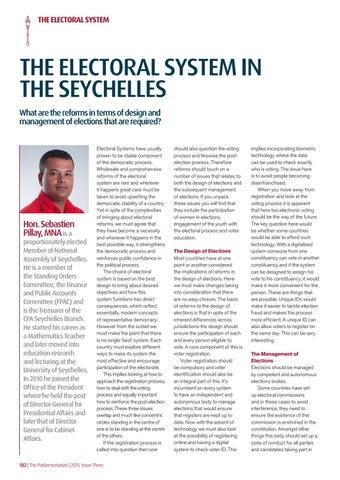THE ELECTORAL SYSTEM
THE ELECTORAL SYSTEM IN THE SEYCHELLES What are the reforms in terms of design and management of elections that are required?
Hon. Sebastien Pillay, MNA is a
proportionately elected Member of National Assembly of Seychelles. He is a member of the Standing Orders Committee, the Finance and Public Accounts Committee (FPAC) and is the Treasurer of the CPA Seychelles Branch. He started his career as a Mathematics Teacher and later moved into education research and lecturing at the University of Seychelles. In 2010 he joined the Office of the President where he held the post of Director General for Presidential Affairs and later that of Director General for Cabinet Affairs.
Electoral Systems have usually proven to be stable component of the democratic process. Wholesale and comprehensive reforms of the electoral system are rare and wherever it happens great care must be taken to avoid upsetting the democratic stability of a country. Yet in spite of the complexities of bringing about electoral reforms, we must agree that they have become a necessity and wherever it happens in the best possible way, it strengthens the democratic process and reinforces public confidence in the political process. The choice of electoral system is based on the best design to bring about desired objectives and how this system functions has direct consequences, which reflect essentially, modern concepts of representative democracy. However from the outset we must make the point that there is no single ‘best’ system. Each country must explore different ways to make its system the most effective and encourage participation of the electorate. This implies looking at how to approach the registration process, how to deal with the voting process and equally important how to reinforce the post-election process. These three issues overlap and much like concentric circles standing in the centre of one is to be standing at the centre of the others. If the registration process is called into question then one
182 | The Parliamentarian | 2015: Issue Three
should also question the voting process and likewise the postelection process. Therefore reforms should touch on a number of issues that relates to both the design of elections and the subsequent management of elections. If you unpack these issues you will find that they include the participation of women in elections, engagement of the youth with the electoral process and voter education. The Design of Elections Most countries have at one point or another considered the implications of reforms in the design of elections. Here we must make changes taking into consideration that there are no easy choices. The basis of reforms to the design of elections is that in spite of the inherent differences across jurisdictions the design should ensure the participation of each and every person eligible to vote. A core component of this is voter registration. Voter registration should be compulsory and voter identification should also be an integral part of this. It’s incumbent on every system to have an independent and autonomous body to manage elections that would ensure that registers are kept up to date. Now with the advent of technology we must also look at the possibility of registering online and having a digital system to check voter ID. This
implies incorporating biometric technology where the data can be used to check exactly who is voting. The issue here is to avoid people becoming disenfranchised. When you move away from registration and look at the voting process it is apparent that here too electronic voting should be the way of the future. The key question here would be whether some countries would be able to afford such technology. With a digitalised system someone from one constituency can vote in another constituency and if the system can be designed to assign his vote to his constituency, it would make it more convenient for the person. These are things that are possible. Unique IDs would make it easier to tackle election fraud and makes the process more efficient. A unique ID can also allow voters to register on the same day. This can be very interesting. The Management of Elections Elections should be managed by competent and autonomous elections bodies. Some countries have set up electoral commissions and in these cases to avoid interference, they need to ensure the existence of this commission is enshrined in the constitution. Amongst other things this body should set up a code of conduct for all parties and candidates taking part in
